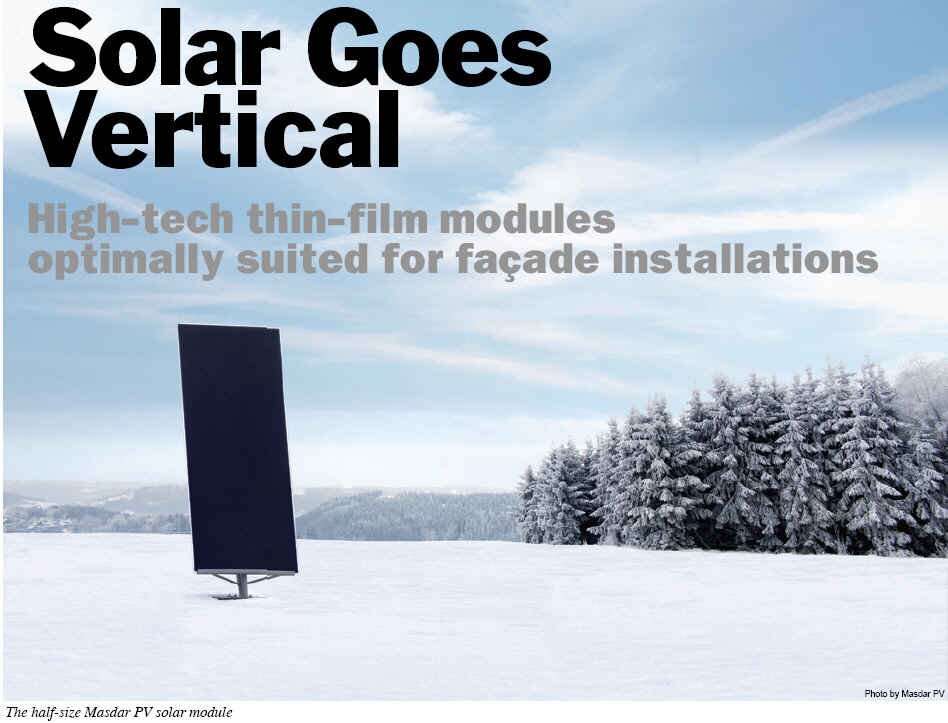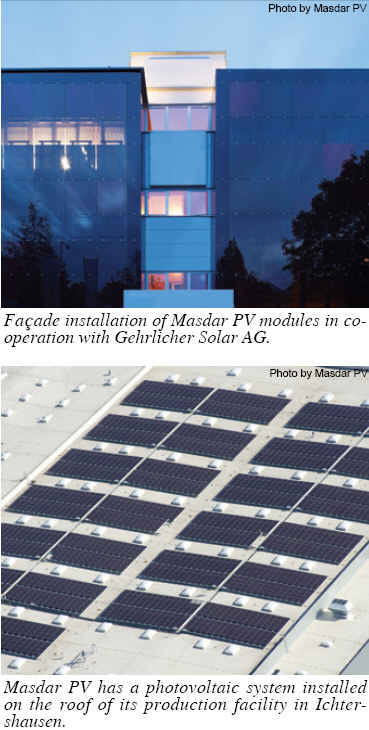By Dr. Ing. Claas Helmke

 Take a mental stroll around downtown Frankfurt, New York City, London, Hong Kong or any big city around the globe in the year 2050. The sleek marble covering the outsides of the various skyscrapers will have disappeared being replaced by advanced photovoltaic modules that give the buildings an aesthetically pleasing and harmonious appearance. Also, the modules provide all the energy needed for air-conditioning, lighting and the workspaces. Take a mental stroll around downtown Frankfurt, New York City, London, Hong Kong or any big city around the globe in the year 2050. The sleek marble covering the outsides of the various skyscrapers will have disappeared being replaced by advanced photovoltaic modules that give the buildings an aesthetically pleasing and harmonious appearance. Also, the modules provide all the energy needed for air-conditioning, lighting and the workspaces.
That is still a vision of the future. Today, solar modules mounted onto rooftops have become a normal sight within the last couple of years. Now a new era starts with modules being attached to the facade of a building or even constituting part of the building envelope. The later solutions are called Building Integrated Photovoltaics or BIPV. Since thin-film silicon modules have accessed the market, they also opened up new areas of utilization that will lead to additional growth for thin-film module suppliers. These modules can now be integrated seamlessly into the very skin of a building, providing a modern and esthetically pleasing exterior while also generating steady energy yields for the owners. This new field of operation suggests a major change within the roadmaps of many PV manufacturers giving a broader diversity to the possible product ranges.
Since Masdar PV entered the solar market with its high-tech thin-film silicon modules in October 2009, many of their modules were installed in ground-mounted solar parks as well as in rooftop installations. The experts at Masdar PV immediately realized that especially large modules are well-suited for BIPV applications, consequently they began to develop modules for facade integration. In August 2010, together with Gehrlicher Solar, Masdar PV set up the first building-integrated installation in Munich utilizing the gehrtechⓒ mounting system.
The facade is composed of a total of 80 modules, each with a size of 1.4 square meters, summing up to a nominal power of 7.1 kWp. To give the facade a harmonious appearance, 16 semi-transparent dummy modules were also installed. This lends the facade a homogeneous and holistic appearance without obscuring the natural lighting of the rooms. The facade was built up by the company Jako Bau-und Verputz GmbH on its own office building, where it is designed to serve as a test installation for this new type of system.
Solutions like these present a number of advantages for customers. On the one hand, the facade surface is used to generate electricity and hence generates continuous returns for the system owner. On the other hand, solar modules integrated into the facade improve the thermal insulation, thus effectively lowering heating costs. Additionally, they provide advanced weathering protection for the building envelope and improve the sound proofing by around 25 decibels. Furthermore, the solar facade significantly enhances the appearance of the building and highlights a fundamental ecological idea.
In addition, the facade also enables high-end thin-film modules to show off their strengths--since these solar modules generate high energy yields even if they are not perfectly oriented towards the sun. Another competitive advantage of these modules is their ability to perform well under a variety of conditions like diffuse lighting as one can find in Germany or in costal areas with high humidity. Therefore, modules can be mounted vertically or parallelly to a flat roof top, (even facing east or west) and still ensure that customers get excellent value for money. Having no stark metal frames facilitates the integration into the very skin of a building.
To install a solar system that is attached to the outside of a house or building, the owner should consult with a system integrator as well as an architect. In Germany, legislation aims to upgrade older buildings and make them more energy efficient. In the future many countries might follow this example. By adding solar modules to the outside of a building, or integrating the modules into the building envelope, real estate owners can comply with the new regulations and improve the efficiency of their properties. Currently, PV enthusiasts or people seeking to make a political statement are acting as early adopters for building attached or integrated solar systems. In the future, aesthetics and the overall appearance of a building will become more relevant since more typical building owners will enter the markets looking for feasible solutions for their buildings.

In the years to come, solar manufacturers, thus, see a high need to level the buildings energy demands by maximizing the energy efficiency. The result will be an overall optimization of the entire energy system, making buildings self-sufficient in their energy supply, and thus reducing costs. And the electricity consumption of a building or apartment will come to play a major role in the customer’s decision to buy or rent a building. Real estate companies may also integrate solar modules as a selling feature into upscale existing office buildings and warehouses, much as they once did with high-end communication methods.
According to the experts at GTM Research, the future possibly lies within building integrated photovoltaics where solar modules substitute building material and are used as windows, to create shading or even to work as roofing or wall building elements. Solar modules are set to become a regular building material, reducing the carbon footprint of a complex. This market could amount to US$6.1 billion by the year 2016 according to the research of NanoMarkets. Currently the U.S. Department of Energy estimates that the deployment of building integrated photovoltaics in the future could generate up to 50% of the country’s electricity needs. But to allow for efficient installations of these photovoltaics a new kind of teamwork has to be forged along the entire supply chain: architects, building designers, engineers, system integrators, module producers, real estate owners and utility companies have to cooperate to ensure the success of a facade installation. They have to interact from the inception of the project until its completion. But the demand to include solar modules into a building and use their aesthetics to enhance the look of a building has not yet reached the architects, thus few ideas are yet spawned leaving the solar industry to develop new ideas, how systems can be attached or integrated into the building envelope.
Based on this realization, many experts have started to work on thin-film modules that offer the possibility to create varying degrees of transparency. At Masdar PV, we are currently working on semi-transparent modules and the first conception study was presented at the 25th European Photovoltaic Solar Energy Conference and Exhibition (EU PVSEC) in Valencia. Modules like these can be used in a multitude of ways, as cladding and curtain walls or for windows as glazing, skylights, sunshades, maybe as a winter garden or even complete roofing, e.g. in train stations or stadiums. All alternatives have one thing in common: the energy expenditure needed to air-condition and cool the various rooms is reduced significantly. Thus a great contribution is made to conserve the environment and reduce carbon emissions. In addition, the modules are going to generate regular energy yields for many years, and this is something a marble facade will never be able to do.
From our point of view, building integrated photovoltaics is going to play an integral part in the future progress of the solar industry and is likewise going to have a major impact on the real estate business. And Masdar PV is prepared to participate and mold the development.
Dr.Ing. Claas Helmke, Manager Marketing, Systems & Service at Masdar PV, started his career in the solar branch in 1993 working for the Joint Research Centre of the European Commission in Ispra, Italy until 2000. Prior to his engagement at Masdar PV, Claas Helmke worked nine years for United Solar Ovonics, the global leading manufacturer of flexible solar modules for Building Integrated Photovoltaics (BIPV) and its customers ThyssenKrupp and Solarintegrated.
For more information, please send your e-mails to pved@infothe.com.
ⓒ2010 www.interpv.net All rights reserved. |



